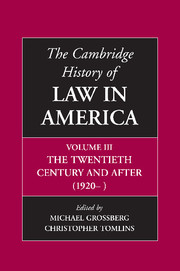Book contents
- Frontmatter
- 1 Law and the State, 1920–2000: Institutional Growth and Structural Change
- 2 Legal Theory And Legal Education, 1920–2000
- 3 The American Legal Profession, 1870–2000
- 4 The Courts, Federalism, and The Federal Constitution, 1920–2000
- 5 The Litigation Revolution
- 6 Criminal Justice in the United States
- 7 Law and Medicine
- 8 The Great Depression and the New Deal
- 9 Labor’s Welfare State: Defining Workers, Constructing Citizens
- 10 Poverty law and income Support: From the Progressive Era to the War on Welfare
- 11 The Rights Revolution in the Twentieth Century
- 12 Race and Rights
- 13 Heterosexuality as a Legal Regime
- 14 Law and the Environment
- 15 Agriculture and the State, 1789–2000
- 16 Law and Economic Change During the Short Twentieth Century
- 17 The Corporate Economy: Ideologies of Regulation and Antitrust, 1920–2000
- 18 Law and Commercial Popular Culture in the Twentieth-Century United States
- 19 Making Law, Making War, Making America
- 20 Law, Lawyers, and Empire
- Bibliographic Essays
- Notes on Contributors
- Index
- References
19 - Making Law, Making War, Making America
Published online by Cambridge University Press: 28 November 2008
- Frontmatter
- 1 Law and the State, 1920–2000: Institutional Growth and Structural Change
- 2 Legal Theory And Legal Education, 1920–2000
- 3 The American Legal Profession, 1870–2000
- 4 The Courts, Federalism, and The Federal Constitution, 1920–2000
- 5 The Litigation Revolution
- 6 Criminal Justice in the United States
- 7 Law and Medicine
- 8 The Great Depression and the New Deal
- 9 Labor’s Welfare State: Defining Workers, Constructing Citizens
- 10 Poverty law and income Support: From the Progressive Era to the War on Welfare
- 11 The Rights Revolution in the Twentieth Century
- 12 Race and Rights
- 13 Heterosexuality as a Legal Regime
- 14 Law and the Environment
- 15 Agriculture and the State, 1789–2000
- 16 Law and Economic Change During the Short Twentieth Century
- 17 The Corporate Economy: Ideologies of Regulation and Antitrust, 1920–2000
- 18 Law and Commercial Popular Culture in the Twentieth-Century United States
- 19 Making Law, Making War, Making America
- 20 Law, Lawyers, and Empire
- Bibliographic Essays
- Notes on Contributors
- Index
- References
Summary
At the close of the First World War, Woodrow Wilson embarked upon a utopian mission. It was not on American soil that armies had slaughtered each other, but Americans had been there in the carnage, and so in its aftermath an American president took up the task of ensuring that it would never happen again. Wilson hoped to create a world body, a League of Nations, and through it order for a lawless world. By such efforts, world leaders thought they might contain a force that had long structured and tortured human affairs and that had become, in their eyes, newly unthinkable due to the horrifying consequences of modern weaponry. The airplanes and submarines that took bloodshed across continents gave the world a new common goal: to end forever the specter of war.
The League is most famous, of course, for its failure, but in that utopian moment we can see an element that would not be lost on the rest of the twentieth century. Americans and others held on to the belief that somehow human action could stave off this most ancient form of politics. And they often turned to law as a means of holding back the forces of war.
War would not be contained by law, of course. Instead, war would be a defining feature of the twentieth century. This meant that war would play a central role in the history of American law.
- Type
- Chapter
- Information
- The Cambridge History of Law in America , pp. 680 - 717Publisher: Cambridge University PressPrint publication year: 2008
References
- 1
- Cited by



